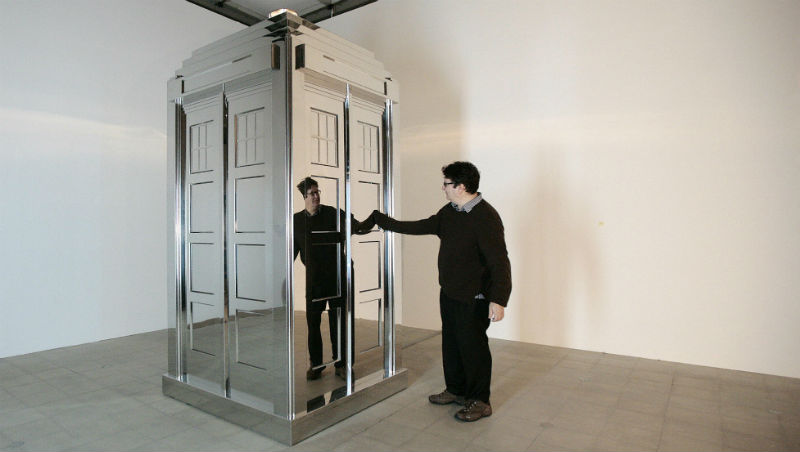Schrodinger's cat explained
The thought experiment lives on – or does it? What Schrodinger's cat tells us about quantum physics

Wanted: dead and alive, for crimes against common sense.
The thought experiment has yet to be resolved, but researchers are still seeking to explain the fate of the cat in the box. Here's how their work may help to explain the building blocks of the universe:
The origins
The Week
Escape your echo chamber. Get the facts behind the news, plus analysis from multiple perspectives.

Sign up for The Week's Free Newsletters
From our morning news briefing to a weekly Good News Newsletter, get the best of The Week delivered directly to your inbox.
From our morning news briefing to a weekly Good News Newsletter, get the best of The Week delivered directly to your inbox.
The thought experiment was devised in 1935 by Austrian physicist and Nobel laureate Erwin Schrodinger. He was responding to a paper by Albert Einstein, Boris Podolsky and Nathan Rosen, which called into question a quantum mechanics theory known as the Copenhagen interpretation (quantum mechanics is the study of tiny subatomic particles).
And that was?
The Copenhagen interpretation, posed in 1920, says that a quantum particle doesn't naturally exist in one state or another, but in all possible states at once (what's known as "coherent superposition"). But when it's observed or measured, the particle is forced to become a single one of those iterations – known as a "classical state" – which is what the observer then sees. Sometimes these particles enter a different classical state upon each observation, which would explain why their behaviour is so erratic.
Where does the cat come in?
A free daily email with the biggest news stories of the day – and the best features from TheWeek.com
To demonstrate the strangeness of the Copenhagen interpretation, Schrodinger's imaginary cat is put inside a steel chamber. Inside there is a Geiger counter containing a tiny amount of radioactive substance – an amount small enough that over an hour it may decay or it may not. If it does decay, a mechanism is triggered to release a flask of acid, which kills the cat. If it doesn't, the flask is unbroken and the cat remains alive. If the Copenhagen interpretation is correct, until the box is opened and the cat and acid are inspected (i.e. "measured"), the atom has both decayed and not decayed. Therefore, the animal is both alive and dead.
Schrodinger is basically asking, at what point does a subatomic particle stop existing in all states and convert to just one? (This moment of change is known as "wave function collapse".) To human intuition, it seems impossible that something can be many things at once. To demonstrate this he imagined an example that, in his own words, was "ridiculous".
Einstein admired the "honesty" of the experiment, saying that many physicists could not see "what sort of risky game they are playing with reality…Nobody really doubts that the presence or absence of the cat is something independent of the act of observation".
The cat example quickly became a touchstone for quantum mechanics researchers and a way for them to explain how their theories differ.
What are the other theories?
There are many, but here are a few. In 1957, American physicist Hugh Everett posited the "many worlds" interpretation. At the moment of opening the box, the world splits in two: one in which the cat is dead, the other in which it is alive. Neither of these worlds has any interaction with the other: to each, only one state is true.
Another famous idea is the quantum Zeno effect, first demonstrated in 1989. This basically posits that a thing cannot change if you are watching it – as Science Alert puts it, "this atomic watched pot would never boil". So, if you checked up on the cat often – in quantum physics terms, "often" is thousands of times a second – its fate would be delayed indefinitely.
There is also the anti-Zeno effect, which essentially says the opposite: that frequent observation, or measuring, can actually accelerate change and force the particle into a single state. By looking into the box you would accelerate the cat's destiny.
In June this year, scientists at Washington University in St Louis came up with a fresh development. They were investigating whether you actually needed to measure – ie collect information – from the particle in order to affect it, or whether disturbing it would be enough to cause a wave function collapse (thereby sealing the fate of the cat).
To grossly simplify, the team used an artificial atom. Since the Zeno effect works only if information collected doesn't leave the system and go into the outside world (as Cosmos describes in a piece entitled, "How Schrodinger could have his cat and see it too", they created something called a "quasi-measurement". This involved creating some interference without allowing the information to leak out – as they described it, the Schrodinger equivalent of shaking the cat's box, but not opening it.
The team found that, just like a full measurement, merely interfering also resulted in wave function collapse.
"Because the Zeno effects have to do with disturbance and not information, it isn't even necessary to look inside the box to provoke them," researcher Patrick Harrington said. "The same effects will occur if you just shake the box."
Why has it become so famous?
The simplicity of Schrodinger's idea has helped popularise the complexities of quantum mechanics, bringing the vanguard of scientific theory into mainstream culture. Terry Pratchett hypothesised that, as well as alive and dead, there was a third state – "Bloody Furious".
The protagonist of Douglas Adams's Dirk Gently's Holistic Detective Agency uses clairvoyance to determine that the cat inside is not alive, or dead, but has grown bored of the experiment and wandered off. And American author Robert Anton Wilson wrote a whole Schrodinger's Cat Trilogy in which each novel discussed a different interpretation of quantum physics.
-
 Pakistan: Trump’s ‘favourite field marshal’ takes charge
Pakistan: Trump’s ‘favourite field marshal’ takes chargeIn the Spotlight Asim Munir’s control over all three branches of Pakistan’s military gives him ‘sweeping powers’ – and almost unlimited freedom to use them
-
 Codeword: December 6, 2025
Codeword: December 6, 2025The daily codeword puzzle from The Week
-
 Crossword: December 6, 2025
Crossword: December 6, 2025The daily crossword from The Week
-
 52 ideas that changed the world - 47. Relativity
52 ideas that changed the world - 47. RelativityIn Depth Einstein’s theory remains ‘most important in modern physics’
-
 What’s in Albert Einstein’s ‘God letter’?
What’s in Albert Einstein’s ‘God letter’?Speed Read Famous note penned by theoretical physicist goes up for auction today
-
 Four ways in which time travel could be possible
Four ways in which time travel could be possibleIn Depth Some physicists are convinced that time travel is possible. Here's how we might move through the fourth dimension
-
 Ten Things You Need to Know Today: Friday 23 Sep 2011
Ten Things You Need to Know Today: Friday 23 Sep 2011Daily Briefing